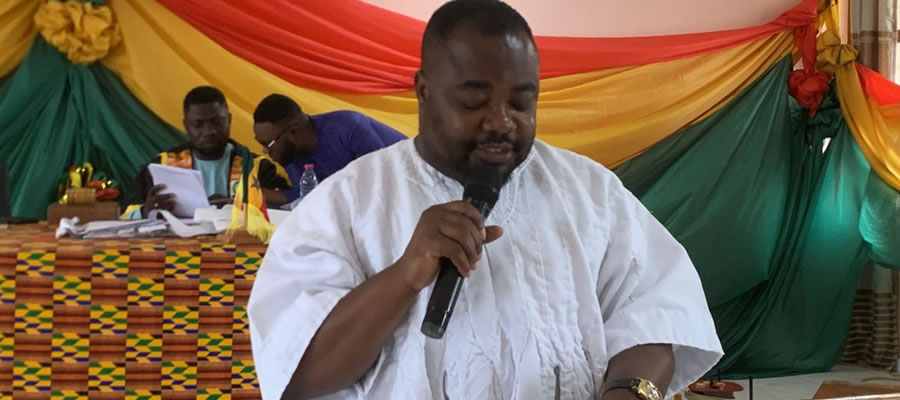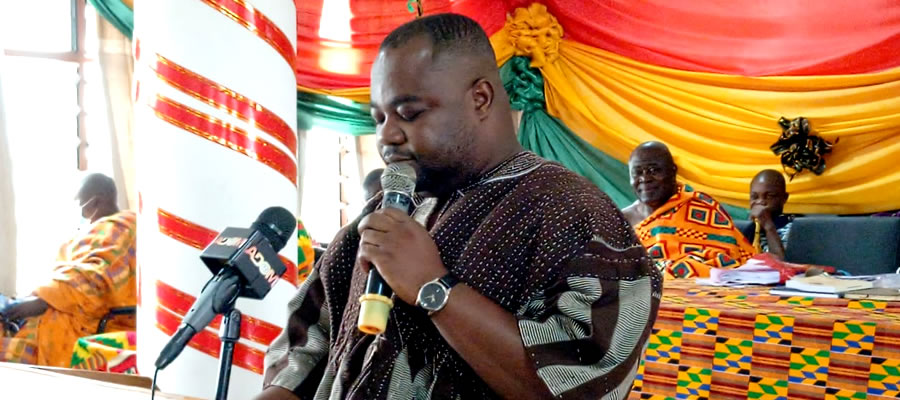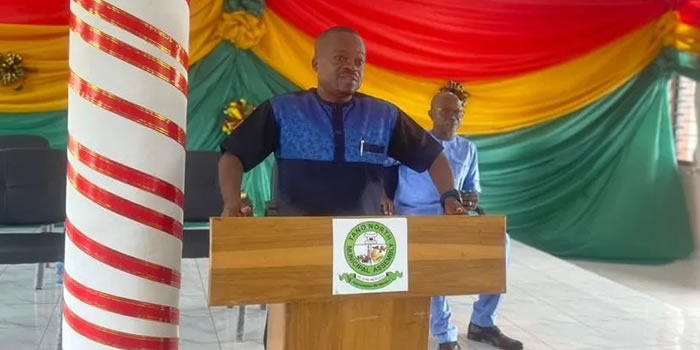

Physical Environment
Location and Size
The Tano North Municipality is one of the twenty-nine Administrative Districts/Municipals in the Brong-Ahafo Region. It was carved out of the Tano District in 2004 with Duayaw-Nkwanta as its Administrative Capital.
The Municipality lies between Latitudes 70 00' N and 70 25'N and Longitudes 20 03' W and 20 15' W. It has a total land area of 837.4 square kilometres and constitutes about 1.8 percent of the total land area of the Brong Ahafo Region. On its western stretch from north to south, the Municipality shares boundaries with Sunyani West District, Sunyani Municipal and Asutifi North District in that order. On the eastern side, Tano North Municipality shares boundaries with Offinso North District in the extreme north-east and Tano South Municipal in the east. In the southern part the Municipality shares boundaries with Asutifi South in the south-west and Ahafo Ano North Municipal in the South-East as shown in (Figure 4).
Topography
The topography of the Municipality is undulating; rising gently from a height of about 270m in the north-west to a peak of about 760m in the south-east. The area is well drained by the Tano River and its numerous tributaries including Subri, Kwasu and Mankran, all of which generally flow from the north-east to the south–west.
Climate
The Municipality lies in the semi–equatorial climatic zone and experiences double maxima rainfall regime, from April–June and September–November. The period between December and March is the dry season characterized by harsh harmattan conditions. The mean annual rainfall of the Municipality is between 125cm and 180cm, and the mean monthly temperature ranges between 260 C (mainly in August) and 300 C (in March). The relative humidity of the area is generally high, between 75 percent and 80 percent during the rainy season and 70 percent and 72 percent in the dry season.
Vegetation
The Municipality has two main vegetation types, the moist semi-deciduous forest, mostly in the southern and south-eastern parts with gross forest cover of about 157.45sq km of which close to 80 percent (132.52sq km) is covered by the following three main forest reserves: Aparipari, Bosomkese and Omankwayemu Forest Reserves. The second dominant vegetation type is the guinea savannah found in the northern and north western parts around Subriso and Yamfo where cattle rearing are predominant (Tano North, 2010).
As far as human settlements are concerned, these forest reserves are seen as a big asset for future generation. Nevertheless, bush fires and other illegal human activities are degrading the forests at an alarming proportion.
Geology and Soils
The geology of the Municipality is basically of the Middle Precambrian Formation with a lot of weathered Birimian rocks, phychites and schist which bear substantial deposits of red and white clay in the basin of the Tano River around Tanoso. There are also vast deposits of gold in the areas around Yamfo, Tanoso, Terchire and Adrobaa. The dominant soil type of the area is forest ochrosols and is generally considered to be fertile and suitable for the cultivation of a wide range of arable crops such as cocoa, coffee, oil palm, plantain, maize, citrus and vegetables.
Temperature and Seasonal rainfall patterns
The Municipal lies in the semi-equatorial zone which experiences two rainy seasons, major and minor. The major season is usually between April and June, with June as its peak. The minor season however, begins from September and ends in November. The mean annual rainfall is between 125cm and 180cm. the dry season is quite severe and occurs in the months of November to March each year. The mean monthly temperature ranges between 260 C (mainly in August) and 300C (in March).
Historic Sites
The most of important Tourist site in the Municipal are the Bosomkese and Apaape Forest Reserves. These serve as the aesthetic and scientific natural resources in the Municipal. In these reserves, one can find different species of tress such as “Odum”, Mahogany, Ceiba, cassia and akasaa. The reserves are of biodiversity importance.
A number of traditional shrines are found in the Municipal. Prominent among these are the Boso`mkese and Apaape at Bomaa. Traditionally, the Tano River is adored throughout Brong Ahafo and Ashanti regions. In Tanoso for instance the river is worshiped with a local priestess responsible for it, because the river is worshiped by the native.
It is a religious taboo to eat fish from the river. Consequently, the river has become conducive habitat for a wide range of fish species, crocodiles etc. which have become invariably friendly to humans. The friendly nature of these creatures has made people both natives and visitors alike stand at the River Banks to feed and admire them. Foods that frequently attract the creatures include bread, kenkey, rice and maize. Worshippers of the river god sometimes offer sacrifices of eggs fowls, sheep and cattle to the river. The goat is however a taboo to the river.
The shrines mentioned above serve as centres for cultural and religious studies for both Ghanaians and foreigners alike. Mention can also be made of one tourist altercation site at Bomaa known as Chain of Hills.
Conditions of the Natural Environment
With the Municipality falling within the semi - deciduous forest and faces serious threat of deforestation through pressures from human and animal activities such as housing expansion, farming, overgrazing, bushfires and timber exploitation. These activities have no doubt contributed to the seasonal drying up of some rivers and other water bodies. It is clear that given the current situation, a lot of conscious and sustained efforts will have to be employed if the natural environment is to be restored and resources sustainably exploited. Afforestation program needs to be supported seriously by the Municipality to bridge the gap between the rate of exploitation and re-stocking of the vegetative cover.
Some of the species in the forests do not only serve as medicinal plants but they could be also be used for carving and other wood works. The Forest Reserves as well serve as habitat for several species of wildlife and game and as good shed for the rivers and streams in the Municipality and beyond.
Implications for development
The location of the Municipality in Brong Ahafo Region offers it the opportunity to interact or co-operate with five other Municipals. The Municipality been located on the Sunyani Kumasi High way makes it imperative for the people to co-operate and exchange goods and services within and outside the region. The proximity of the Municipality to Sunyani, the Regional capital has both advantages and disadvantages.
The Municipal is fortunate to lie in the semi–equatorial climatic zone and experiences double maxima rainfall regime. The double maxima rainfall supports two crop seasons making it continuous food supply throughout the year within and outside the Municipal. Extensive dry seasons also lead to a long period of drought which does not augur well for agriculture.
The rainfall pattern and adequate sunshine support the growing of crops like Cassava, Plantain, tomatoes, and garden gardens among others to thrive well. The existence of large deposits of red and white clay in the basin of the Tano River as well as deposits of gold has implications for development. The gold can be exploited and provide employment for inhabitants around the area. However, this exploitation can also affect the environment by depleting the vegetation and soil. The clay deposits can also be used for ceramics, glazed ware and provide employment.
Conditions of the Built Environment
Tano North Municipal has five major settlements which can be classified as towns, while the rest are minor settlements; villages and hamlets. The settlements (‘large towns and small towns’) are generally nucleated while the minor settlements are greatly dispersed in pattern thus influencing the distribution of services.
According to the 2010 Population and Housing Census results, the main materials used for the outer walls of dwelling units are cement block or concrete (49.4%) and mud brick or earth (43.2%). Seven out of 10 (71.7%) dwelling units in the Municipal have cement or concrete as main material for the floor constructed and about one quarter (26.6%) of the dwelling units have earth or mud floors. Irrespective of locality of residence, the main material used for roofing dwelling units in the Municipal is metal sheets (89.1%).
In terms of access to sanitation facilities in dwelling units in the Municipal, About two-fifth (40.2%) of households in the Municipal use separate bathrooms shared in the same house. One-fifth (21.6%) exclusively use their own bathrooms while 18.5 percent share open cubicles with other households. In the case of toilet facilities, Public toilet is used by 49.4 percent of households in the Municipal. About one-third (33.1%) of the households, use pit latrine while 6.8 percent also use KVIP. Only 5.5 percent of households in the Municipal use WC toilet facility.
Households that dispose of their solid waste at public dump in a container form 16.1 percent. Indiscriminate dumping of solid waste is common among 10 percent of the households. Public dumping in open spaces are common among urban (54.8%) and rural (59.9%) households. Households in urban areas (21.3%) are more likely than those in rural areas (9.8%) to dump their solid waste in containers. Contrariwise, households in rural areas (15.7%) are more likely than those in urban areas (5.3%) to dump their solid waste indiscriminately.
Regarding settlement planning, all the five major towns in the Municipality have planning schemes or layouts for their efficient development. However, compliance with land acquisition, development procedures and non-adherence to planning schemes is very low particularly in major settlements such as Yamfo and Bomaa. Some chiefs in the Municipality have taken upon themselves the responsibility to demarcate and allocate plots without following the existing planning scheme. This has also accounted to destruction of most of the planning schemes and led to many unauthorized developments in almost all the towns in the Municipality.
This does not only drawback efforts being made to ensure effective settlement management but also makes the community vulnerable to disasters.
To help check this there is the need for continuous monitoring of physical developments, planning education and site inspections. There is also the need to evacuate unauthorized structure and punish perpetrators to serve as a deterrent to others. There should be a collective effort between the Assembly and Traditional leaders to ensure that planning regulations are adhered to.
From the table, it could be observed that apart for Duayaw Nkwanta, the rest of the settlement do not adhere to building regulations and permits. This can make the Municipal aesthetically unattractive. There is the need to encourage the traditional authority to prepare Planning schemes to ensure control in building development in their locality.
Date Created : 11/20/2017 7:04:42 AM












 facebook
facebook
 twitter
twitter
 Youtube
Youtube
 +233 593 831 280
+233 593 831 280 0800 430 430
0800 430 430 GPS: GE-231-4383
GPS: GE-231-4383 info@ghanadistricts.com
info@ghanadistricts.com Box GP1044, Accra, Ghana
Box GP1044, Accra, Ghana